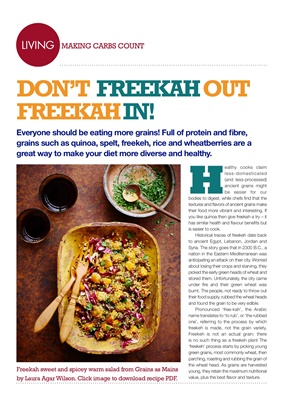
LIVINGLIVING MAKING CARBS COUNT
Everyone should be eating more grains! Full of protein and fibre,
grains such as quinoa, spelt, freekeh, rice and wheatberries are a
great way to make your diet more diverse and healthy.
DON'T FREEKAH OUT
FREEKAH IN! Healthy cooks claim
less-domesticated
(and less-processed)
ancient grains might
be easier for our
bodies to digest, while chefs find that the
textures and flavors of ancient grains make
their food more vibrant and interesting. If
you like quinoa then give freekah a try - it
has similar health and flavour benefits but
is easier to cook.
Historical traces of freekeh date back
to ancient Egypt, Lebanon, Jordan and
Syria. The story goes that in 2300 B.C., a
nation in the Eastern Mediterranean was
anticipating an attack on their city. Worried
about losing their crops and starving, they
picked the early green heads of wheat and
stored them. Unfortunately, the city came
under fire and their green wheat was
burnt. The people, not ready to throw out
their food supply, rubbed the wheat heads
and found the grain to be very edible.
Pronounced 'free-kah', the Arabic
name translates to 'to rub', or 'the rubbed
one', referring to the process by which
freekeh is made, not the grain variety.
Freekeh is not an actual grain; there
is no such thing as a freekeh plant The
'freekeh' process starts by picking young
green grains, most commonly wheat, then
parching, roasting and rubbing the grain of
the wheat head. As grains are harvested
young, they retain the maximum nutritional
value, plus the best flavor and texture.
Freekah sweet and spicey warm salad from Grains as Mains
by Laura Agar Wilson. Click image to download recipe PDF.